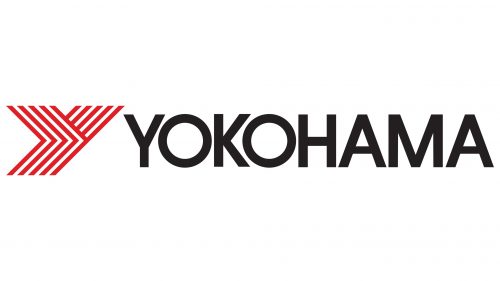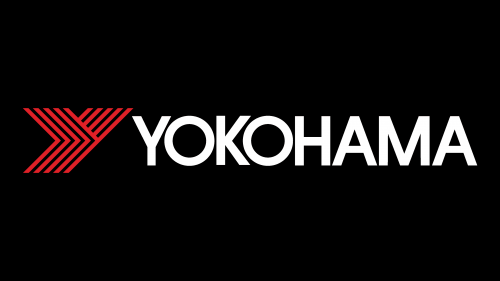The Yokohama logo vividly represents the uniqueness of the Japanese tire manufacturer. It conveys the company’s reliability and celebrates the national heritage of the country where it is based. The emblem marks high-quality products, historical heritage, and a confident outlook.
Yokohama: Brand overview
The Japanese city of Yokohama saw the beginning of its existence in 1917. Yokohama Cable Manufacturing and the American B.F. Goodrich Company established the business as a joint venture. The Yokohama Rubber Company, Limited was its original name.
When the company first started, its primary concentration was producing tires for cars and aircraft. At this early stage in the development of the Japanese automotive industry, the firm was crucial in addressing the increasing need for tires.
The business saw tremendous expansion in the 1920s. The company increased output and started shipping tires to other Asian nations. The “Hamatown,” its first passenger automobile tire, was introduced in 1921.
Technological breakthroughs dominated the 1930s. In 1930, the firm invented the first pneumatic tire for trucks and buses in Japan, greatly enhancing the company’s standing in the commercial tire market.
Like numerous Japanese enterprises, the company was compelled to transition to manufacturing war equipment during World War II. The business produced tires for aircraft and military vehicles.
The company suffered difficulties following the war due to the devastation of its manufacturing facilities and Japan’s economic downturn. However, the business bounced back fast and started producing civilian products again.
The firm saw a period of recovery and modernization during the 1950s. By investing in new machinery and technology, the company could boost output and enhance product quality.
The company started actively broadening its international reach in the 1960s. An important milestone in the brand’s global expansion was reached in 1969 when the company launched its first overseas office in the USA.
The company entered the market for high-performance tires in the 1970s. In 1978, the firm introduced its first passenger car radial tire, marking a crucial turning point in its history.
The company continued its global expansion in the 1980s, setting up production sites in the USA and other nations. As a result, the company was able to lower logistical expenses and be closer to its important markets.
The firm saw significant technological advancements during the 1990s. In addition to tires with better performance characteristics for high-performance automobiles, the company unveiled several innovative technologies.
The company increased its visibility in motorsports by supplying tires to racing series in the 2000s. This helped the corporation test its innovations in harsh environments and enhanced the brand’s reputation.
Sustainable development was a major theme throughout the 2010s. Low rolling resistance tires, which lower fuel consumption and CO2 emissions, are among the eco-friendly technologies the business introduced.
The company commemorated its 94th anniversary in 2011 and kept bolstering its market share in tires worldwide. In response to the increased demand for ecologically friendly and energy-efficient products, the firm launched a new range of eco-friendly tires that year called BluEarth.
The firm increased its industrial capacity in 2012. A new plant for the corporation was opened in Jefferson, Mississippi, USA. The facility was state-of-the-art and focused on manufacturing tires for trucks and buses.
The business continued its global expansion in 2013. For $1.2 billion, the company bought a majority share in Alliance Tire Group, an Indian tire producer. Through this acquisition, the firm increased its market share in the quickly developing Indian market and solidified its position in the industrial and agricultural tire sectors.
In 2015, the business made significant advancements in sports marketing. The company became Chelsea Football Club’s official tire supplier when it inked a sponsorship agreement with the English squad. As a result of this cooperation, the firm’s brand recognition expanded dramatically, especially in Europe and Asia.
“Mound Profile Design,” a new tire manufacturing technology released by the company in 2016, is used in the high-performance ADVAN Sport V105 tires.
The business achieved notable strides toward sustainability in 2018. The company’s “Grand Design 2050” plan aims to be carbon neutral by 2050.
Notwithstanding the difficulties in the world economy in 2020, the firm kept up its innovative initiatives. In response to the rising need for adaptable tires in areas with moderate climates, the company unveiled the new BluEarth-4S AW21 all-season tire line, which blended the qualities of summer and winter tires.
The company celebrated its 104th anniversary in 2021 and kept bolstering its market share in the world tire industry. The business unveiled the ADVAN Sport V107 tire range for high-performance cars.
In 2022, the business made notable progress in sustainability. The tire manufacturer used recycled carbon from old tires in its production plant.
By launching a dedicated tire line for electric vehicles in 2023, the company increased its market share in the electric vehicle industry. These tires were created to meet the special needs of electric cars, such as reduced rolling resistance for longer ranges and enhanced sound absorption.
In 2024, the business made an important technological advancement. The company revealed the idea of “smart” tires, which have sensors to continuously check the state of the road and the tires themselves. This technique was intended to improve tire efficiency and safety.
Meaning and History
What is Yokohama?
It is a Japanese brand known for manufacturing tires. The company produces tires for various vehicles, including cars, trucks, and industrial machinery. The brand is known for performance and reliability in the tire industry, offering products designed for different driving conditions and needs. The tires are popular worldwide and used in everyday and performance vehicles such as motorsports.
1917 – today
The Yokohama emblem has two key elements: a wordmark and a graphic symbol. The lettering is executed in uppercase. The letters are smooth, even, and clean. Their strict contours give the logo a confident and professional appearance, indicating that it represents a strong company.
Although the glyphs are classic, the inscription creates a sense of avant-gardism. This impression arises from the letters’ perfect size and distinctive arrangement: for instance, the “O” is neatly fitted into the inner space of the adjacent “K,” which seems to want to engulf it. A similar situation occurs with another pair, “Y” and “O,” where the “Y” resembles a half “K.”
The avant-garde spirit is also conveyed through the tight placement of the symbols: the distance between them is so small that they almost touch each other. The key word here is “almost,” as the glyphs are only close at the bottom, with their outward-projecting legs. The exception is the letter “O,” whose sides are widened.
The font lacks serifs, demonstrating the company’s readiness to listen to customer needs and meet them when solving problems with wheel equipment. It is a marker of precision, meticulousness, and high standards. The bold, monochromatic letters inspire trust and signify the reliability of the products.
Even more symbolic is the tire manufacturer’s mark. It represents the first glyph of the brand’s name, “Y,” stylized as a tire tread pattern. The symbolic letter is formed by five parallel arrow-shaped stripes intersected by another similar element, smaller in size and positioned at an angle. This construction resembles a road with a diagonal fork, aligning with the company’s theme.
The straight strokes also serve as speed lines, filling the Yokohama logo with passion, energy, and movement. Furthermore, they embody confidence, determination, and commitment to the chosen principles. Their straightness and sharp angles celebrate progressiveness and professionalism.
The classic combination of red and white reinforces everything mentioned above, conveying the brand’s powerful energy. These colors also reflect the brand’s national heritage, country of origin, and uniqueness, as they are closely tied to Japan’s cultural traditions and are featured on the national flag.






